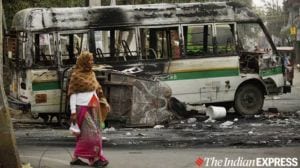Big Brother watches you every moment at Srinagar Airport
SRINAGAR, JAN 16: The Srinagar Airport figures in the supersensitive category for obvious reasons: vulnerable to hijacking of airliners by...

SRINAGAR, JAN 16: The Srinagar Airport figures in the supersensitive category for obvious reasons: vulnerable to hijacking of airliners by militants and also because of it’s strategic significance for the Indian Air Force (IAF).
The Airport is actually located 11 kms south-west of Srinagar in Budgam district. It is one of the high-altitude airports in the country. Civilian flights apart, the IAF also uses it for its operations. Unlike other civilian airport, the Air Traffic Control (ATC) here is managed by the IAF.
Though the IAF has a fully operational base at Kaul in the south Kashmir district of Pulwama, it still retains control on some portion of the Srinagar airport, where as per the sources it retains MIG series and other fighter planes.
The airport was closed for repairs for six months in June 8 to December 31 in 1998. During this period, the IAF base at Kual was thrown open for commercial flights. It was later learnt, the closure was done to upgrade the airport for operating the state-of-the-art Sukhoi-30 fighter-planes acquired from Russia. Defence experts feel in case of a war, the SU-30s would better operate from here rather than Kual.
The security at the airport is perhaps the most stringent of all. Passengers are screened at five check-points, starting from the entrance, one km before the departure hall. The airport security comes directly under Inspector General police (security wing) and the CRPF.
The anti-hijacking squad operates under SP airport. The police is responsible for the internal security, right upto the tarmac, which is the last security point for the passengers. The outer security — funnel duty — is the exclusive responsibility of the CRPF. The CRPF also keeps a close watch on all kinds of moment in and around the airport from watch-towers encircling the airport.
The first check-point is the main gate one km before the airport building. The passengers are frisked by metal detectors and the luggage is checked both manually and also screened through x-rays. The second check takes place at the building entrance, where the passengers are frisked and luggage passes through a x-ray. After collecting the boarding pass, the passengers are subjected to the most stringent check — security check.
The next check takes place at the tarmac prior to boarding the plane. However, during emergencies, the passengers are checked seven to eight times like the early nineties.
The VIPs, VVIPs, ministers or chief minister also pass through the same security chain. “Nobody is excused whatever the status,” a security officer told The Indian Express. “We cannot afford to be complacent, given the sensitive nature of this airport. At the most, their luggage is handled well and they are treated with respect, but they enjoy no immunity to checks,” he added.
It was the second attempt to storm the airport. Earlier, the militants had managed to barge into this supersensitive installation on January 7. However, they had failed at that time.
Photography is strictly prohibited outside the airport, upto several hundred metres. Intelligence gathering operations highten during the Haj flights. The police or any other agency has not conducted any mock exercise of hijacking or of any other emergency to date.
One of the striking feature of the anti-hijacking squad is their timing: they report in the morning but strangely leave in the afternoon, leaving everything to the CRPF that appears to be the only loophole. The Central Industrial Security Force are not involved.



- 01
- 02
- 03
- 04
- 05




























